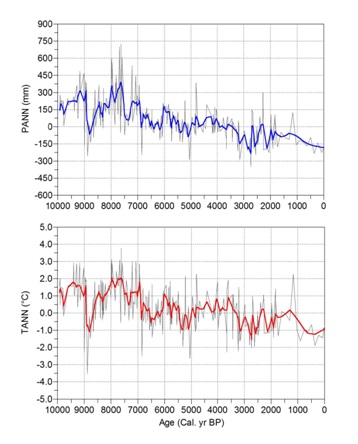The Yangtze River Delta (YRD) has long been known as a cradle of rice agriculture and historical civilization in East China. At present, the YRD, also called Changjiang Delta, is one of the most important economic and cultural centers in China as well as the world. Geographically speaking, it has very low elevations ranging from 3 to 5 m above sea level, indicating that it is therefore highly vulnerable to extreme climate events such as floods, high tides, and typhoons.
The modern climate of the YRD region is controlled by the East Asian monsoon system which is an important component of the global climate system and plays a significant role in global hydrological cycles. Understanding the past monsoonal history especially temperature and precipitation changes is thus fundamental for predicting the possible effects of climate change on social and economic developments of the YRD area in the future.
However, the long-term changes of temperature and rainfall in the YRD region over the last 10,000 years are largely unknown. In particular, the underlying forcing mechanisms for the climate change in the YRD are also unclear. Moreover, the past extreme climate events such as flooding and their influences on prehistorical society and culture in the YRD are not fully understood.
A new research led by Dr. LI Jianyong and colleagues from Britain, Australia, and Hong Kong, developed robust pollen-based reconstruction models for temperature and precipitation, and hence applied these models to three fossil pollen records from the YRD region, so as to provide the first 36-year resolution dataset for temperature and precipitation spanning the last 10,000 years for this climatically sensitive area.
The results showed that both temperature and precipitation obtained the highest level between 10,000 and 7000 years ago, suggesting a warm, wet climate and a strong East Asian summer monsoon (Fig. 1). The climate reconstructions revealed a declining pattern for both temperature and precipitation during the last 7000 years, indicating a cooling, drying climate, as well as weakening summer monsoon strength.
In addition, they found several extreme cold, dry climate events at about 5200, 4200, 2800 years ago and during the Little Ice Age period. Such short-lived climate events may play a critical role in affecting the abrupt depression of Eolithic cultures such as the Liangzhu Culture in the YRD region.
The inter-regional comparison suggested that the variations of temperature and rainfall in the YRD area during the last 10,000 years may be attributed to tropical or subtropical large-scale climatic circulations including the Intertropical Convergence Zone, Western Pacific Subtropical High, and El Ni?o/Southern Oscillation, thereby suggesting a regional-scale climatic teleconnections (Fig. 2).
This work has been recently published by an international journal “Climate Dynamics” (Li, J.Y., Dodson, J., Hong, Y. et al., 2017, Quantitative Holocene climatic reconstructions for the lower Yangtze region of China, Climate Dynamics, DOI: 10.1007/s00382-017-3664-3).This study was funded by the CAS "Light of West China" Program and the National Science Foundation of China (NSFC).

Fig. 1 Pollen-based PANN and TANN estimates during the last 10,000 years for the lower Yangtze region of China (Image by Li et al.)

Fig. 2 Holocene comparison of pollen-inferred PANN and TANN records for the lower Yangtze region (LYR) of China with other climatic proxy records from subtropical and tropical regions of the world (Image by Li et al.)
Contact: LI Jianyong, State Key Laboratory of Loess and Quaternary Geology, Institute of Earth Environment, Chinese Academy of Sciences, Xi'an 710075, China. Email: lijy@ieecas.cn
 © 2015 Institute of Earth Environment,CAS
© 2015 Institute of Earth Environment,CAS Address:No. 97 Yanxiang Road, Xi'an 710061, Shaanxi, China

 Location :
Location :